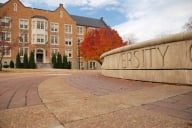You have /5 articles left.
Sign up for a free account or log in.
By now the chorus of complaint is well-rehearsed: Institutions that enroll significant numbers of part-time and adult students blast the federal graduation rate for failing to capture the educational outcomes for what, in some cases, can represent a majority of their student bodies. Though often unstated, the underlying suggestion is that a more complete picture would also present a more positive one.
A report to be released today, however, suggests that that may not be the case. The report, from the national group Complete College America, purports to present for the first time data on the educational progress of all postsecondary students (part-time and full-time, those in developmental courses, etc.) in several dozen states, providing a fuller look at how successfully students are moving through public higher education.
The results are not terrifically encouraging. Extrapolating a bit from the 33 states that provided data on their public higher education systems, the report, "Time Is the Enemy," reveals that the educational outcomes of the students invisible in most such counts of performance lag badly. Among the findings:
- Fewer than a quarter of part-time students attain their target credential (certificate, associate, bachelor's), even when given twice the normal time. Part-time students are half as likely as full-time students to earn a credential in that time.
- Fully half of associate degree seekers and 20 percent of bachelor’s degree seekers require remedial coursework in college, and those students are significantly less likely than the average student to earn their chosen credential in 150 percent of the standard time.
- Black and Latino students and those from low-income backgrounds -- especially those who are part time -- underperform their peers.
- The average student at all levels takes many more credits than are required to earn the credential, with the biggest excess occurring at the certificate level, where the average student takes 68.5 credits for 30-credit certificates.
"The data suggest that if there were a fuller count [of college completion], it would present a picture that’s worse," said Stan Jones, president of Complete College America. "If you were to create a combined rate [including full-time and part-time students], it would be lower."
Complete College America collected its data from 33 states that have in whole or in part agreed to report information about students to conform to the “common completion metrics” developed by the group and the National Governors Association. The states contributing to the report enroll about 10 million students in their public colleges, roughly half of all students in the country.
The new data make several things more clearly apparent than has been possible before, the report asserts. While it has been generally understood (and is not surprising) that part-time students take longer to graduate and may be less likely to, given the financial and life impediments they often encounter, the extent of that gap was striking. Nearly 28 percent of full-time students seeking one-year certificates earned those credentials within two years; for part timers, the figure was 12.2 percent. (Certificate seekers, full time and part time, also took proportionately longer to earn their credentials than did degree-seeking students; full-time students took an average of 3.3 years to earn a one-year certificate, while part-time students took an average of 4.4 percent.)
Those findings suggest that "staying in school longer doesn’t significantly increase students’ chances of graduating," the report asserts. "For instance, giving full-time community college students one extra year to earn an associate degree and giving full-time college students two extra years to earn a bachelor’s degree only increases graduation rates by 4.9 percent -- for both groups."
The data from the 33 participating states provide a wealth of information about how students are faring at the state level. But Jones acknowledges that the statistics are most useful at the national level, where the samples are bigger.
That acknowledgment probably won't stop some critics from questioning the data in the report, given the missing states (and the missing data from some participating states). But Jones believes that the group's effort to collect data that the federal government hasn't ("though it could," he argues, without a change in federal law) and its national extrapolations are valid. "We are not Collect Data America, and we're only doing it because the federal government hasn't," he said. "Maybe if all 50 states were participating, the graduation rate for part-time bachelor's students would be 28 percent, not the 24 percent we report. We might be off by 5 percent, but no matter what it's still awful."
The group's suggestions for improving the picture?
- Count all students, set state- and campus-level goals, and uniformly measure progress and success. "More states should do the same. And the federal government should try to catch up by filling damaging gaps in the national database, raising the standard of measurement, and counting every student in our country."
- Reduce the time it takes to earn a certificate or degree. "This does not mean 'dumbing down' courses or undermining quality. Ensure that unnecessary credit requirements are not added to certificate and degree programs. Demand robust, comprehensive transfer agreements across campuses, systems, and states so students can easily take their hard-earned credits with them instead of losing valuable time when they must continually start over."
- Transform remediation so that students earn -- as quickly as possible -- college credits that count. "Start as many underprepared students as possible in first-year, full-credit classes. Do this by adding extra class time and tutoring support, but don’t make the students wait to earn credits that count toward their degrees."
- Restructure programs to fit busy lives. "The best approaches 'block' classes: Students attend full-time by learning from 8 a.m. to 2 p.m., five days a week. [C]reate cohorts so similar students can support one another."









